The digital art exhibition “behind the black mirror” in Luznava's manor encourages visitors to look into the future
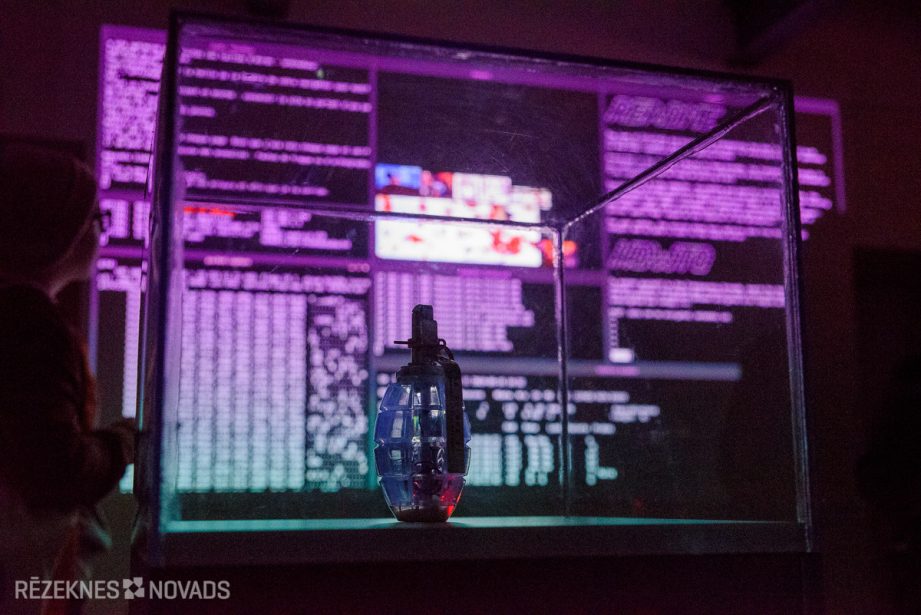
A digital art exhibition “through the Black Mirror/behind the black mirror” was presented at Luznava Manor basement until July 14, in which artists from France, England, New Zealand and Switzerland participate in their works. The exhibition was opened IN THE international symposium of EUCIDA (European digital art network) “Reality Turn/Reality”, which took place in Luznava Manor on 15-16 May. This is the third digital art exhibition of the European Connections in Digital Arts project — EUCIDA (digital art covers Europe) is held at Luznava Manor. The project's leading partner is the digital art centre RUA RED Dublin (Ireland) in collaboration with Espace Multimedia Gantner (France) and the municipality of Rezekne (Latvia). The project is supported by the “creative Europe” programme and aims at establishing cooperation between digital artists and cultural acquaintants in Europe, thereby developing innovation and promoting the popularity of digital art at international level.
The title of the exhibition “behind the black mirror” is not selected by chance – it calls for the understanding of the audible and unheard side of digital technologies, the close relationship between physical and virtual reality. “The idea of an exhibition is to show what we don't hear, make us hear or see what we don't see, but what we don't see.” Black mirror - This is the black screen of our computers and phones when they are turned off, but that doesn't mean they don't work, they're turned on on the network and continue to run. Like the science fiction series of a similar name, the exhibition “through the Black Mirror” represents our Middle future, which is most closely related to what we already exist around us, but we do not yet know what it is and what we will be faced with, ”- that is what the courier Valerie Perrin (France) says about the idea of the exhibition.
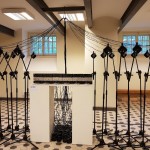
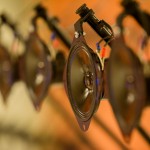
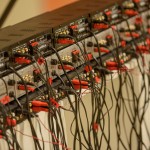 The first work of the exhibitor is the sound sculpture of French artist Cecile Babiole. “Bzz” (2012), which attracts strange sounds. These are the electric crackers that we don't hear in real life. The sculpture is built in the form of a beam, the centre is a sound wave generator, surrounded by 24 speakers attached to the microphone stand. The generator with the speakers is connected to the audio cables that form a tree-like form. Six different sound circles rotate through the microphones, symbolizing the history of technology and the simple, analogue sound in the era of digital technologies.
The first work of the exhibitor is the sound sculpture of French artist Cecile Babiole. “Bzz” (2012), which attracts strange sounds. These are the electric crackers that we don't hear in real life. The sculpture is built in the form of a beam, the centre is a sound wave generator, surrounded by 24 speakers attached to the microphone stand. The generator with the speakers is connected to the audio cables that form a tree-like form. Six different sound circles rotate through the microphones, symbolizing the history of technology and the simple, analogue sound in the era of digital technologies.
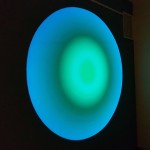
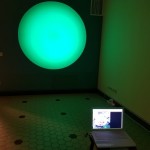
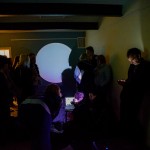 In the next room, there are two works that visually and emotionally affect the viewers. The first of these is the work of the Swiss artist Monica Schtudee and Christoph van den Berg (Monica Studer & Christoph van den Berg) INCL. I.P./travel 2009-2010. It shows a screen that changes the circle of different rotating and flashing colors. In return, a portable computer on which the LSD is on the screen. The work shows a man's special relationship with a computer that he often perceives as a living creature, a companion, one in his isolation and loneliness. When you click a picture with a computer mouse, you can select one of the tablets. A warning of damage to health appears on the wall screen, like cigarettes and alcohol, while the rotating color circle shows the reaction of the computer to the imaginary drug – colours are worrying, restless, even horrible. INCL. I.P. (Transcendance for Real and implicit Personalities – Transcendence of real and implicated personalities) addresses people's dependence on digital devices – a new, modern drug.
In the next room, there are two works that visually and emotionally affect the viewers. The first of these is the work of the Swiss artist Monica Schtudee and Christoph van den Berg (Monica Studer & Christoph van den Berg) INCL. I.P./travel 2009-2010. It shows a screen that changes the circle of different rotating and flashing colors. In return, a portable computer on which the LSD is on the screen. The work shows a man's special relationship with a computer that he often perceives as a living creature, a companion, one in his isolation and loneliness. When you click a picture with a computer mouse, you can select one of the tablets. A warning of damage to health appears on the wall screen, like cigarettes and alcohol, while the rotating color circle shows the reaction of the computer to the imaginary drug – colours are worrying, restless, even horrible. INCL. I.P. (Transcendance for Real and implicit Personalities – Transcendence of real and implicated personalities) addresses people's dependence on digital devices – a new, modern drug.
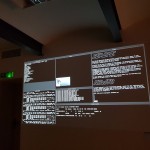
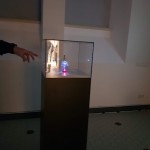
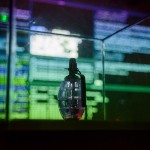 In turn, New Zealand artist Giuliano Oliver “The Transparency Grenade”/Transparency Granate ", 2012 detects human fragility and vulnerability in the virtual world. The work consists of a miniature computer, a microphone and a strong wireless antenna. When it is active, it passes the surrounding WiFi network. IP addresses, user names, unencrypted email fragments, photos, sounds appear on the screen. The idea of the main artist was to show the risk of a daily connection to various public internet networks, whether it was an airport, station, supermarket, anywhere where WiFi is. It is a very dangerous, fragile moment, like a grenade, because it puts our digital device at risk, because we each need to make sure that others can get into your phone and keep track of all your activities in a second, so this danger is visualized as a grenade-portable weapon that can turn into a dangerous weapon. The work was created in 2012, however, when technology develops, the mechanisms for protecting digital devices are better and this access is no longer so simple, but it is possible.
In turn, New Zealand artist Giuliano Oliver “The Transparency Grenade”/Transparency Granate ", 2012 detects human fragility and vulnerability in the virtual world. The work consists of a miniature computer, a microphone and a strong wireless antenna. When it is active, it passes the surrounding WiFi network. IP addresses, user names, unencrypted email fragments, photos, sounds appear on the screen. The idea of the main artist was to show the risk of a daily connection to various public internet networks, whether it was an airport, station, supermarket, anywhere where WiFi is. It is a very dangerous, fragile moment, like a grenade, because it puts our digital device at risk, because we each need to make sure that others can get into your phone and keep track of all your activities in a second, so this danger is visualized as a grenade-portable weapon that can turn into a dangerous weapon. The work was created in 2012, however, when technology develops, the mechanisms for protecting digital devices are better and this access is no longer so simple, but it is possible.
Two major British artist Suzanne Traister works can be seen in the third room (left) “5 Historical Diagram”/5 historical charts, (2009-2011) and “From the other symptom — Time Travelling with Rosalind Brodsky”/no other symptom – travel with Rosalind Brodsk, (1999). This work has been created 20 years ago and has already become a history, as a start-up for digital art, so that this exhibition shows digital art at different times.
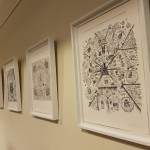
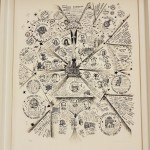
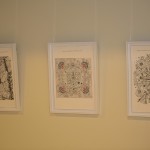 Suzanne Treistere is one of the first digital media and internet artistic designers that can be called pioneers in digital art, but she has now turned to drawing. Five fine-drawn charts show links between technology, philosophy, military, history, meditation. These drawings are filled with information, so you must look very carefully to understand what is recorded there, but each of these charts is a major result of the study.
Suzanne Treistere is one of the first digital media and internet artistic designers that can be called pioneers in digital art, but she has now turned to drawing. Five fine-drawn charts show links between technology, philosophy, military, history, meditation. These drawings are filled with information, so you must look very carefully to understand what is recorded there, but each of these charts is a major result of the study.
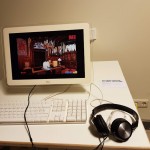
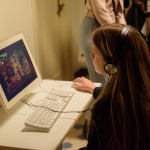
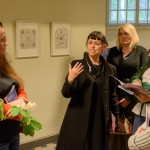 At the end of the exhibition, the participants are invited to play in an exciting computer game, along with an imagined person Rozalindi Brodsk, who was born in 1970, but died in 2058. This journey takes place in the year of death of the old lady, so that it is a journey, but it is crowded with humor. The viewer must sit down on the computer and try THE Brodsk travel through history, wars, you can hear the sounds Rosalind is going through with that person in a variety of fictitious situations and geographical locations.
At the end of the exhibition, the participants are invited to play in an exciting computer game, along with an imagined person Rozalindi Brodsk, who was born in 1970, but died in 2058. This journey takes place in the year of death of the old lady, so that it is a journey, but it is crowded with humor. The viewer must sit down on the computer and try THE Brodsk travel through history, wars, you can hear the sounds Rosalind is going through with that person in a variety of fictitious situations and geographical locations.
Four years ago, the Restored Luznava Manor in Rēzekne municipality has become a real art Citadele, where artists, musicians, literates from different countries gather in exhibitions, concerts and creative workshops. There are also exhibitions of future artists and designers. Currently, a student exhibition of the Rēzekne Technology Academy (RTA) design study programmes is open at the Manor Blue Hall, where student creative experiments in product design are considered – decorative functional light objects, suits and accessories thereof. This exhibition is also part of THE digital art project EUCIDA, in collaboration with THE RTA physical process and the laser technology research centre (FPLPC), which gave the prospective specialists and existing enthusiasts of design, art and engineering industry to expand their vision, realize ideas and create new products using laser technologies.
The digital art is emotional, shocking, speaking and thinking about today's topical problems - ecology, natural pollution, human social isolation, loneliness and fragility in both physical and virtual world.
In collaboration with the exhibition curator Valerija Perin and the manager of Luznava Manor, Iveta Balzni was prepared by Anna Rancāne
Photo: Eduards Medvedev, Anna Ranāne